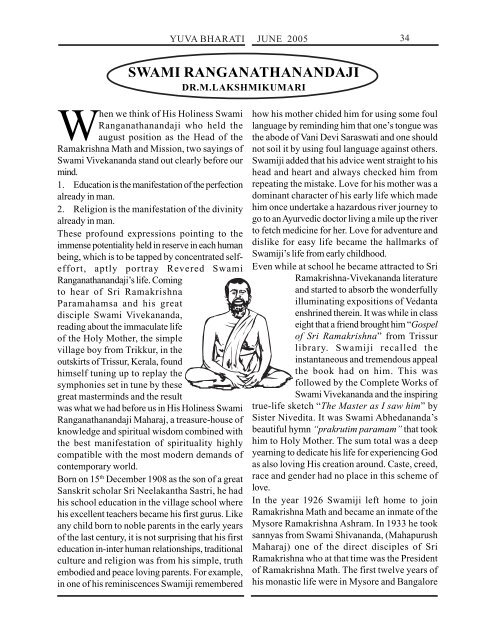YUVA BHARATI - Vivekananda Kendra Prakashan
YUVA BHARATI - Vivekananda Kendra Prakashan
YUVA BHARATI - Vivekananda Kendra Prakashan
You also want an ePaper? Increase the reach of your titles
YUMPU automatically turns print PDFs into web optimized ePapers that Google loves.
When we think of His Holiness Swami<br />
Ranganathanandaji who held the<br />
august position as the Head of the<br />
Ramakrishna Math and Mission, two sayings of<br />
Swami <strong>Vivekananda</strong> stand out clearly before our<br />
mind.<br />
1. Education is the manifestation of the perfection<br />
already in man.<br />
2. Religion is the manifestation of the divinity<br />
already in man.<br />
These profound expressions pointing to the<br />
immense potentiality held in reserve in each human<br />
being, which is to be tapped by concentrated selfeffort,<br />
aptly portray Revered Swami<br />
Ranganathanandaji’s life. Coming<br />
to hear of Sri Ramakrishna<br />
Paramahamsa and his great<br />
disciple Swami <strong>Vivekananda</strong>,<br />
reading about the immaculate life<br />
of the Holy Mother, the simple<br />
village boy from Trikkur, in the<br />
outskirts of Trissur, Kerala, found<br />
himself tuning up to replay the<br />
symphonies set in tune by these<br />
great masterminds and the result<br />
was what we had before us in His Holiness Swami<br />
Ranganathanandaji Maharaj, a treasure-house of<br />
knowledge and spiritual wisdom combined with<br />
the best manifestation of spirituality highly<br />
compatible with the most modern demands of<br />
contemporary world.<br />
Born on 15 th December 1908 as the son of a great<br />
Sanskrit scholar Sri Neelakantha Sastri, he had<br />
his school education in the village school where<br />
his excellent teachers became his first gurus. Like<br />
any child born to noble parents in the early years<br />
of the last century, it is not surprising that his first<br />
education in-inter human relationships, traditional<br />
culture and religion was from his simple, truth<br />
embodied and peace loving parents. For example,<br />
in one of his reminiscences Swamiji remembered<br />
<strong>YUVA</strong> <strong>BHARATI</strong> JUNE 2005 34<br />
SWAMI RANGANATHANANDAJI<br />
DR.M.LAKSHMIKUMARI<br />
how his mother chided him for using some foul<br />
language by reminding him that one’s tongue was<br />
the abode of Vani Devi Saraswati and one should<br />
not soil it by using foul language against others.<br />
Swamiji added that his advice went straight to his<br />
head and heart and always checked him from<br />
repeating the mistake. Love for his mother was a<br />
dominant character of his early life which made<br />
him once undertake a hazardous river journey to<br />
go to an Ayurvedic doctor living a mile up the river<br />
to fetch medicine for her. Love for adventure and<br />
dislike for easy life became the hallmarks of<br />
Swamiji’s life from early childhood.<br />
Even while at school he became attracted to Sri<br />
Ramakrishna-<strong>Vivekananda</strong> literature<br />
and started to absorb the wonderfully<br />
illuminating expositions of Vedanta<br />
enshrined therein. It was while in class<br />
eight that a friend brought him “Gospel<br />
of Sri Ramakrishna” from Trissur<br />
library. Swamiji recalled the<br />
instantaneous and tremendous appeal<br />
the book had on him. This was<br />
followed by the Complete Works of<br />
Swami <strong>Vivekananda</strong> and the inspiring<br />
true-life sketch “The Master as I saw him” by<br />
Sister Nivedita. It was Swami Abhedananda’s<br />
beautiful hymn “prakrutim paramam” that took<br />
him to Holy Mother. The sum total was a deep<br />
yearning to dedicate his life for experiencing God<br />
as also loving His creation around. Caste, creed,<br />
race and gender had no place in this scheme of<br />
love.<br />
In the year 1926 Swamiji left home to join<br />
Ramakrishna Math and became an inmate of the<br />
Mysore Ramakrishna Ashram. In 1933 he took<br />
sannyas from Swami Shivananda, (Mahapurush<br />
Maharaj) one of the direct disciples of Sri<br />
Ramakrishna who at that time was the President<br />
of Ramakrishna Math. The first twelve years of<br />
his monastic life were in Mysore and Bangalore

















